In the early morning hours of April 6, 2008, six CH-47 Chinook helicopters lifted from the airfield at Jalalabad in eastern Afghanistan, carrying an assault force of some 140 Afghan and American troops. Their mission, designated “Commando Wrath,” was to kill or capture a band of insurgents gathered in a remote region near the Pakistan border.
Their destination was the Shok Valley in Nuristan province in the rugged Hindu Kush, an offshoot of the Himalayas. It is isolated territory, just north of the Khyber Pass and accessible only by foot or pack mule. The Russians, in their 10-year occupation of Afghanistan, never got to the Shok Valley, and American forces had never been there either. The mountain villages were insurgent strongholds.
The target was the Hezb-e Islami al Gulbuddin (or HIG) terrorist group, meeting in the valley with Taliban fighters. The provincial governor had been tipped off that Gulbuddin Hekmatyar, founder of HIG, was on hand as well. Bagging Hekmatyar himself would be a substantial bonus. He had been a paramilitary commander since the days of the Soviet invasion. In the 1990s, he was briefly prime minister two times, but then left the country and linked up with Osama bin Laden and al Qaeda. The United States designated him as a terrorist in 2003.
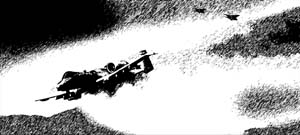 |
An A-10 attack aircraft joins the fight at the Shok Valley in this artist’s conception. |
US Army Special Forces Capt. Kyle M. Walton was in command of the assault force, which consisted of 40 Americans and about 100 Afghan commandos. There were three teams, each with an ODA—a 12-man Operational Detachment Alpha, core unit of the US Special Forces—and one-third of the Afghan troops.
Walton would personally lead ODA 3336 and its associated part of the Afghan commandos against the main objective while the other two ODAs secured secondary objectives scattered out for more than a mile up and down the valley.
Each of the ODAs had its own Air Force combat controller, qualified as a joint terminal attack controller, to direct supporting air strikes. Air Force SrA. Zachary J. Rhyner, 21, of Medford, Wis., was aboard the first Chinook inbound. He joined the Air Force in 2004, completed combat control training in 2006, and was assigned to the 21st Special Tactics Squadron at Pope AFB, N.C. He was on his first deployment to Afghanistan, and was embedded with ODA 3336.
Air Force SSgt. Robert Guiterrez Jr. was on one of the following Chinooks. He was deployed from RAF Mildenhall, Britain, and was the combat controller for ODA 3312, assigned to an objective farther down the valley. The third combat controller with the force was Air Force SrA. Cory Madonna, attached to an ODA that would attack an insurgent position a kilometer to the north of the main assault.
Quiet to 100 Miles an Hour The Shok Valley cuts southwest through the high mountains at an elevation of almost 10,000 feet. In April, a fast-moving river, fed by melting snow, ran down the middle of the ravine with cliffs rising to 160 feet on either side. Most of the terrorists were in the village on a finger of land at the top of the cliffs.
The noise of the approaching helicopters ruled out any possibility of surprise, but Walton and his troops hoped they could catch the insurgents before they were fully prepared. The intelligence estimate said there were about 70 combatants in the village. In fact, there were 200. As the Chinooks descended toward the landing zone at the bottom of the cliffs, insurgents scurried for firing positions in stone houses and holes dug into the canyon walls. AH-64 Apache attack helicopters and two F-15E fighters circled overhead.
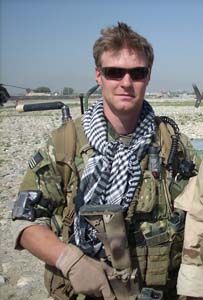 |
SSgt. Zachary Rhyner at a forward base in Afghanistan. (USAF photo) |
The helicopters could not land on the jagged rocks on the valley floor, so the soldiers had to jump the last 10 feet. Many of them landed waist deep in the icy water. Walton took advantage of the view provided by the F-15E’s targeting pod. “They asked me to get them the best route of ingress from the riverbed to the village itself,” said Capt. Prichard Keeley, weapons system officer on one of the F-15s. “I chose the terrain that was least exposed to enemy gunfire and the easiest point of ingress, while avoiding the most mountain climbing.”
Walton and his troops pulled themselves up a five-foot wall and climbed the hillside by way of “switchbacks,” or terraced farm plots. Rhyner, going in with the lead element of ODA 3336, carried 80 pounds of gear, including two radios and an M-4, the carbine version of the M-16 rifle.
The insurgents waited, and then opened fire when the soldiers were partway up the slope. “It went from quiet to 100 miles an hour in 30 seconds,” said Capt. Jeremy Duffey, pilot of one of the F-15s. Guiterrez and ODA 3312, on the other side of the river and a short distance to the south, were also under fire. They could hear and see the main engagement but were not in position to help.
The insurgents poured on a heavy fire from machine guns, rocket-propelled grenades, and AK-47s. Within minutes, the detachment interpreter, standing next to Walton, was shot in the head and killed. The only protection was a shallow wadi in the rock.
“When the enemy opened fire, I was on a narrow terrace, about 60 feet up from the bottom of the valley and six feet wide, with little to no cover,” Rhyner said. “The only cover we had were additional terraces [and] switchbacks sloping up toward the village, and we were trapped on the terrace with the enemy owning the high ground. The fire came from 360 degrees from various prepared fighting positions and fortified structures with multiple sniper positions.”
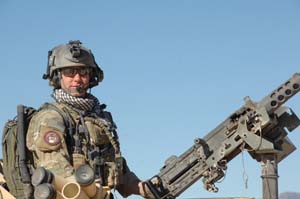 |
Rhyner, a combat controller, mans a gun in Afghanistan. ( USAF photo) |
Rhyner was shot in the leg. “The rounds hit my left thigh and went through my leg and hit another guy in the foot,” he said. Walton treated Rhyner’s injury as Rhyner called in air strikes. The Apaches and the F-15s swept down with rockets and strafing runs to hold the insurgents back. The battle was on. It would last for the next six hours.
Walton’s team was pinned down on the mountainside. Lethal fire from above had the terraces covered, and several more soldiers were soon down with serious wounds. An Afghan commando was killed.
Danger Close Air Support Rhyner was in constant communication with the fighters overhead and with the joint air command and control center at Bagram Air Base, north of Kabul. “I was next to Captain Walton throughout the majority of the operation,” Rhyner said. Rhyner advised Walton on the choices and effects of aerial munitions, but Walton had to concur on the air strikes, especially if they were of the “danger close air support” kind, in which the weapons would impact in close proximity to friendly forces. An additional hazard was falling rocks and debris from the bombing at the top of the slope.
However, the team was at less risk from the bombs than from the insurgents, who approached within 40 feet at one point. Walton’s force was nearly overrun twice, and would have been, had not Rhyner, with Walton’s agreement, repeatedly called in very close air support. It helped that some of the munitions employed were precise laser guided bombs.
A-10 attack aircraft arrived to join the fight about an hour after it started. The two F-15Es remained overhead for three hours, refueling twice, before running out of munitions and being replaced by two other F-15Es. The air strikes held back the insurgents and took a toll on the shooters. Still more fell to small-arms fire from the assault force. SSgt. Seth Howard, who had trained as a sniper, picked off one terrorist after another.
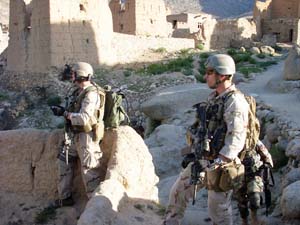 |
|
Across the valley, Guiterrez was directing strikes by the fighters and helicopters against a terrorist village to the south. “Zach and I were in constant radio contact,” Guiterrez told Capt. Laura Ropelis for a report in Air Force Print News. “I could hear the ammunition, sniper fire, and rocket-propelled grenades with multiple blasts. We tried to push to the north to collocate with Zach’s team, but every time we pushed up the river, it put us in an open line of fire. My team ran across the freezing river. The water came off the mountains and we were 100 to 200 feet beneath the enemy, like fish in a barrel.”
Three hours into the battle, Guiterrez climbed up to confer briefly with Rhyner, but his ODA remained on the valley floor, taking what cover they could and adding their rifle fire to that of Walton’s team on the slope. “Zach was coordinating tremendous amounts of fire on both villages simultaneously,” Guiterrez said. “Zach was in charge of the air strikes, since he was closest to the fight and could see what the F-15 pilots could not.”
“Cloud cover was coming in, and there was no certainty we would be able to get out that night,” Walton said. “So we didn’t waste our ammo. We really didn’t fire unless we had a shot or when we needed to lay suppressive fire to allow people to move.”
The assault force had been on the hillside for almost six hours when intelligence notified Rhyner that enemy reinforcements, carrying rockets and missiles, were 10 miles away.
“Our higher command told us we had to get out of there,” Walton said. “Most of the objective was gone at that point, but our casualties were mounting. … They became our priority. … When the weather rolled in, we could be stuck there at least overnight, possibly for days.”
It was time to get off the terrace. Rhyner conferred with Walton, who authorized the use of the biggest weapon the fighters had, a 2,000-pound bomb, dropped almost on top of the team’s position. It was a highly accurate Joint Direct Attack Munition, guided by a GPS signal from space, but the impact point was just 100 feet up the slope. Walton hoped the explosion would kill or daze the insurgents, and it did all of that.
With rocks still falling from the bomb blast and the other ODA adding fire support from the ravine, Walton’s team bumped and slid down the hillside, hanging onto branches and rocks. The less seriously wounded helped carry the most seriously wounded. It was rough going for the injured—especially the last 20 feet, which was a steep drop—but better than waiting until the insurgents regained their wits. Howard, the sharpshooter, was the last American off the cliff. Rhyner was next to last.
Without Regard for His Life UH-60 Black Hawk medevac helicopters, with bullets pinging off their fuselages, picked up the worst of the wounded and took them to the hospital at Bagram. The rest of the force was extracted from a landing zone farther down the valley. Back at base, Rhyner was treated at the clinic. “I got some pills—antibiotics—and was good to go,” he later told Air Force Times. He remained in Afghanistan until his tour was finished.
According to some official estimates, 150 to 200 insurgents were killed in the Shok Valley battle. A more likely count is 40 killed and around 100 wounded. Casualties for the assault force were two killed, both Afghans, and 100 wounded. From the number of weapons used and the amount of ammunition expended, intelligence concluded that the insurgents had been stockpiling guns and ammunition in the village since the 1980s. Gulbuddin himself, if he was there, escaped. He was soon active again, and was still a strong factor in Afghanistan in 2010.
In December 2008, the US Army awarded 10 Silver Stars, the most for any single battle in Afghanistan, to Walton and members of ODA 3336 for their action in the Shok Valley.
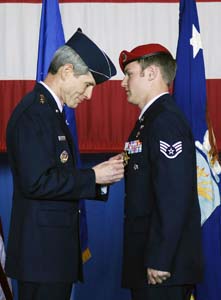 |
Gen. Norton Schwartz, USAF Chief of Staff, pins on Rhyner’s Purple Heart medal, moments after Air Force Secretary Michael Donley pinned on an Air Force Cross. ( USAF photo) |
In March 2009, Secretary of the Air Force Michael B. Donley presented the Air Force Cross to Rhyner before his home unit, the 21st Special Tactics Squadron, at Pope. Gen. Norton A. Schwartz, Air Force Chief of Staff, presented Rhyner with the Purple Heart medal.
Among those on hand to see it was his mother, Sue Rhyner. “I couldn’t be prouder,” she said. “Zack is part of an awesome group of individuals who personify teamwork, something he learned early on, being one of five children.”
“Without regard for his life, Airman Rhyner placed himself between the most immediate threats and provided suppressive fire with his M-4 rifle against enemy fire while fellow teammates were extracted from the line of fire,” the citation for the Air Force Cross said. “Airman Rhyner bravely withstood the hail of enemy fire to control eight United States Air Force fighters and four United States Army attack helicopters.
“Airman Rhyner controlled more than 50 attack runs and repeatedly repelled the enemy with repeated danger close air strikes, several within 100 meters of his position. Twice, his actions prevented his element from being overrun during the intense six-and-a-half hour battle.”
Rhyner is the only living combat controller recipient of the Air Force Cross. Another Pope combat controller, TSgt. John A. Chapman, was posthumously awarded the Air Force Cross for heroism under fire in Afghanistan March 4, 2002.
Since then, Rhyner has had more deployments “downrange” to Afghanistan. He has been promoted to staff sergeant and is still assigned to the 21st Special Tactics Squadron at Pope.
John T. Correll was editor in chief of Air Force Magazine for 18 years and is now a contributing editor. His most recent article, “Take It Down! The Wild Weasels in Vietnam,” appeared in the July issue.